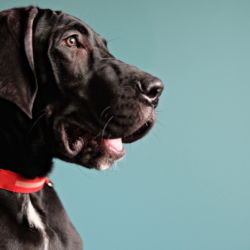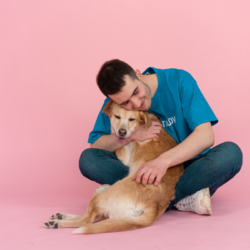Dogs, faithful and loving companions, can sometimes develop behavioural problems that disrupt their daily lives and those of their owners. These disorders are varied and often complex. They can include aggressive behaviour, phobias,separation anxiety and compulsive behaviour. Understanding the causes and manifestations of these disorders is essential if you are to remedy them effectively and improve your dog’s well-being.
Hypersensitivity-hyperactivity syndrome
Hypersensitivity-Hyperactivity Syndrome (Hs-Ha) is a developmental disorder resulting from a dysfunction of the sensory filter (hypersensitivity) and a motor control deficit (hyperactivity). Development in a hypo-stimulating environment prevents the acquisition of an effective sensory filter. This leads to an inappropriate reaction to stimuli, characteristic of hypersensitivity.
Motor control, essential for biting and motor activity, is acquired with the mother or an adult educator during the first 5 weeks. Early separation or an overly tolerant mother can cause a motor control deficit, resulting in hyperactivity. A dog with Hs-Ha syndrome displays hypertrophied motor activity, a low threshold of reactivity to sensory stimuli, biting, aggression, destruction and sleep disorders.
There are two stages of Hs-Ha syndrome:
- Stage 1: Absence of bite control, inability to stop a behavioural sequence, hypervigilance, near-normal food satiety, absence of sleep disturbance.
- Stage 2: Symptoms similar to stage 1, but with absence of food satiety and reduced sleep time (< 8 h).
Hs-Ha syndrome often progresses to anxiety disorders, secondary hyper-aggression, learning disabilities, sociopathy and secondary hyperattachment. Spontaneous recovery is very rare.
Deprivation syndrome
Deprivation syndrome manifests itself as fear or dread of certain stimuli. This is the result of development in a hypo-stimulating environment. The puppy’s sensitive period extends from 4 weeks to 3 months, during which it establishes its sensory homeostasis threshold. This syndrome occurs when the puppy grows up in an unstimulating environment that is different from the one in which it will live later on, for example a puppy raised in a quiet country kennel and adopted in the city.
There are three stages to the symptoms:
- Stage I: Few identifiable fear-triggering stimuli (cars, firecrackers). Reactions: flight, inhibition, avoidance, or aggression through irritation or fear.
- Stage II: Numerous stimuli that are difficult to identify. Behaviours: flight, inhibition, avoidance and aggression, static exploratory postures. Nocturnal feeding, frequent uncleanliness.
- Stage III: Signs of depression, inhibition, sleep disturbance. Fear reactions may diminish thanks to the reassuring role of their owners, but the syndrome often persists or worsens, leading to secondary disorders such as anxiety, sociopathy and social isolation.
Prevention is based on providing a stimulating environment for puppies before they are 3 months old. Breeders should enrich the environment with a variety of objects and noises, and get puppies used to travelling in cars. Owners should expose the puppy to a variety of stimuli without encouraging fearful reactions.
Sociopathy
Sociopathy in dogs is a common disorder linked to problems of social organisation within the family group. It results from communication problems between the owner and the dog, a social animal living in a pack. Often observed at puberty, it is caused by the owner assigning dominance prerogatives to the dog, creating social incoherence and leading to anxiety and aggression.
The symptoms fall into two categories:
- Non-aggressive behaviour: Destruction in the absence of the owner, vocalisations, hierarchical elimination (urine/faeces in evidence), hypervigilance, pseudogestation, pseudophobia.
- Aggressive behaviour: Triad of sociopathies – hierarchical aggression, irritation and territorial aggression.
Hierarchical confusion causes anxiety manifested by hypervigilance, irritant aggression and substitutive activities (licking, bulimia). Sociopathy can evolve into instrumentalised biting.
The owner plays a crucial role by attributing dominance prerogatives, often through ignorance or overprotection (deprivation syndrome). Examples:
- Feeding: The dog begs and obtains food.
- Control of space: The dog sleeps on the bed or in strategic places.
- Contact initiative: The dog asks for petting and gets it.
- Sexuality: A dominant male dog attacks the husband in the mistress’s bed.
An intense emotional relationship can mask the need to impose constraints, thus favouring sociopathy.
Anxiety
Anxiety is an emotional disorder characterised by neurovegetative manifestations similar to fear and exacerbated substitute activities. It appears in various behavioural pathologies such as HsHa, deprivation syndrome, primary dyssocialisation, sociopathy, deritualisation and replacement dogs. Certain organic disorders such as dysendocrinia, pain or sensory dysfunction can also cause anxiety.
Symptoms are presented in three clinical pictures:
- paroxysmal anxiety with tachycardia, tachypnoea, diarrhoea, vomiting, salivation, emotional urination, panic attacks and convulsions
- intermittent anxiety with ptyalism, recurrent vomiting, hypervigilance, hypertrophy of motor behaviour, aggression and substitute activities
- permanent anxiety with inhibition, sadness and various substitute activities such as licking and bulimia.
Paroxysmal anxiety is stable, while intermittent anxiety may develop into permanent anxiety or dysthymia. Permanent anxiety may remain stable thanks to secondary hyperattachment or develop into dysthymia or depression. Left untreated, anxiety is self-perpetuating and worsens, reducing the dog’s ability to learn and communicate.
The owner often plays a role in the anxiety, often through anthropomorphism and a blurred social framework. Explaining the dog’s place, improving communication and providing a suitable environment are essential to reducing anxiety.
Hyperattachment
Secondary hyperattachment is an exaggerated attachment of the dog to its owner in reaction to another disorder, acting as an emotional crutch to preserve the balance of the dog in distress. Detachment therapy should not be undertaken until the initial disorder has been treated.
The disorders that cause secondary hyperattachment include Hs-Ha, deprivation syndrome, sensory homeostasis disorder, and primary dyssocialisation. The symptoms resemble those of separation anxiety, but it is crucial to differentiate between the two conditions as their origins and treatments differ. Symptoms include:
- In the absence of the owners: spectacular destruction, scattered or localised urination/defecation due to emotional stress, and distress vocalisations.
- In the presence of the owners: clingy dog, following everywhere, demanding a lot of attention without necessarily requiring permanent physical contact.
The owner plays a key role. Some owners detach themselves from the dog by punishing it for its destructive behaviour, thereby aggravating its emotional disorder and creating a vicious circle. Others, flattered by the dog’s attachment, encourage this behaviour, especially in lonely people. The owner should not try to detach the dog before the initial disorder has been resolved. Reframing the dog in its place as a dog helps to reduce its anxiety.
Communication disorders
Dog communication is based on the transmission, reception and interpretation of visual, auditory and olfactory signals. Communication disorders occur when the dog cannot manage these signals properly, affecting interactions between dogs (intraspecific) and with humans (interspecific). Intraspecific disorders can be caused by a learning defect, sensory impairment (blindness, deafness), defective pheromone emission, or interruptions to behavioural sequences. These disorders lead to increased aggression,anxiety or intraspecific sociopathy.
Interspecific disorders result from owners’ lack of knowledge of canine communication, developmental disorders or sensory alterations. This leads to ambivalent communication, aggression, excessive rituals and anxiety. Interspecific sociopathy is manifested by destruction, vocalisations, elimination, hypervigilance and aggression. It is diagnosed by the presence of dominant prerogatives in the dog and at least two specific symptoms such as the aggression triad and hierarchical urination.
Social phobias are characterised by the avoidance of social interactions and fearful reactions, often in the form of aggression. The attitude of owners can aggravate these phobias.Deritualisation anxiety, caused by a change in social group, leads to hyperfocussing, withdrawal, aggression and stereotypies. It can develop favourably or lead to mood disorders.
Age-related disorders
Age-related disorders fall into three categories:
- Social behaviour disorders: Hyperaggressiveness in the old dog, characterised by unstructured aggression in which the threat phase follows the bite and appeasement is absent. Submissive postures are no longer enough to prevent aggression. These dogs are often bulimic, and the underlying mechanisms remain poorly understood.
- Cognitive disorders: The confusional syndrome of the old dog, marked by impaired learning (particularly housetraining) and spatial and temporal disorientation, attributable to cerebral ageing.
- Thymic disorders: These include involutional depression and old dog dysthymia. Involution depression is a chronic depression associated with a marked loss of behavioural skills acquired through socialisation. Old dog dysthymia begins with unipolar, then bipolar dysthymia, accompanied by an inability to assess the relationship between the width of a passage and the width of one’s own body, and an obsession with forcing the passage.





